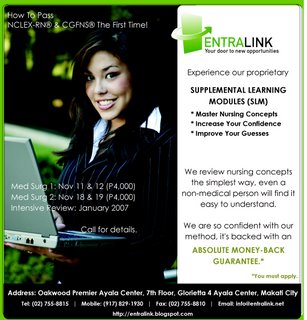Christmas Holiday Message
Twelve months ago, I was looking forward to the year 2006. In December 2005, I was enjoying the best year ever since NC STAFFING was established. The company I started in 2001 was experiencing record-breaking growth both in the number of nurses and in sales revenue.
At this very moment, I am doing exactly the same thing; looking back & looking ahead. Both years somewhat share the same spirit of contemplation, confidence, and optimism but the past year 2006 was a very special and a life-changing event for me. It was a life-changing event since I never imagined myself leaving my husband, my family, and my business behind to embark on an endeavor thousands of miles away- to start the Intensive Review and the Supplemental Learning Module (SLM). There was a lot of sacrifice on my part, but my husband's unwavering support was the biggest blessing ever. A colleague once asked why waste my time on a venture that is so highly competitive.
Looking back, if I ever have to make a choice, I would do the same thing again. Why? I don't feel like I am wasting my time. I am actually investing my time in making a difference. It was very encouraging to hear from each one of you that I made a difference. Yes, EntraLink and NC STAFFING are here to stay. We are here to open your door to opportunities and be successful at it. The vision of Entralink & NC STAFFING is not limited to helping you pass the NCLEX & CGFNS the first time, but in opening your door to the the many opportunities.
In behalf of the staff of EntraLink and the Review Team, I would like to express my thanks and gratitude for your unlimited support, dedication, loyalty, and confidence. The EntraLink family is growing because of you and your contribution. I am very proud to say that most of you have been sending your friends and have been sharing your wonderful experiences about the EntraLink family. I hope that you will continue to share your experiences about us to all your friends because it's giving me the biggest opportunity to reach as many nurses as I can. I realize that some are misguided with false information and limited choices when it comes to Nursing in the US. Now, is the time to share what you know.
EntraLink is making a difference because of you and the wonderful staff at EntraLink. My thanks to all the hardwork of the staff: Tim, Nancy, Yolly, Ghie, Rose, Alain, Jenny, Coy, Roilo, Nino & Angelo. Those from the US: Christine, Tina, Ace, Andy, Dorry, Mel, Amanda, Rimi, Barbara, Dr. Morris, Quandara, Jean Jackson, and those who helped us in our transition. And most importantly, for my very supportive & encouraging husband, Steve Adams. But above all, for God's sustaining Blessings and Goodness.
Again, thank you All. I wish you the Best Year/s Ahead. I am looking forward to seeing you in January.
PAPASAKAYO!
Best Wishes and Warmest Regards,
Ann H. Adams
Chairman, EntraLink
President, NC STAFFING
anna@entralink.net
aadams@ncstaffing.com
annh67@yahoo.com



